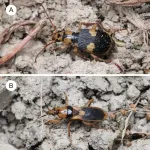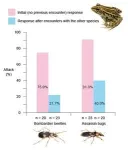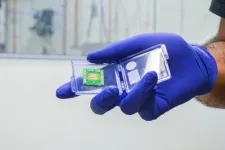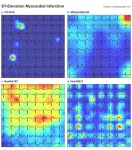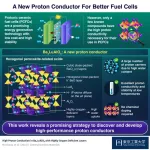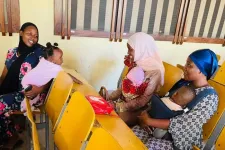(Press-News.org) Animals can defend themselves against their natural enemies in various ways. Well-defended species often share conspicuous body colors with other well-defended or undefended species, forming mimetic interactions. Bombardier beetles eject toxic chemicals at a temperature of 100°C to repel enemies such as frogs, and many have warning body colors that function to deter enemies. An assassin bug, Sirthenea flavipes, exhibits a conspicuous body color similar to the bombardier beetle Pheropsophus occipitalis jessoensis which coexist with the assassin bug in the same habitat in Japan (Fig. 1). The assassin bug can stab with its proboscis, causing severe pain in humans. Although both insects are well defended, the mimetic interaction between the bombardier beetle and the assassin bug remains unclear.
Japanese entomologists Shinji Sugiura (Kobe University) and Masakazu Hayashi (Hoshizaki Green Foundation) found that the bombardier beetle P. occipitalis jessoensis has a stronger defense against a shared predator compared to the assassin bug S. flavipes. They also showed that both the bombardier beetle and the assassin bug benefit from the mimetic interaction via the shared predator. Their research appears in the 6 June 2023 issue of PeerJ.
In central Japan, the pond frog Pelophylax nigromaculatus coexists with the bombardier beetle and the assassin bug in the same habitat. The pond frog, which is well known as a predator of various insects, could potentially attack the bombardier beetle and the assassin bug under field conditions. The researchers observed the behavioral response of pond frogs to bombardier beetles and assassin bugs under laboratory conditions (see video). Among the frogs, 100% rejected bombardier beetles and 75% rejected assassin bugs (Fig. 2), suggesting that the bombardier beetle is better defended against frogs than the assassin bug. The researchers also provided a bombardier beetle or an assassin bug to a frog that had encountered the other insect. Frogs that had previously encountered one insect species were less likely to attack the other species (Fig. 3). Specifically, a history of encounter with assassin bugs reduced the rate of attack on bombardier beetles by frogs from 75.0% to 21.7% (Fig. 3). A history of encounter with bombardier beetles reduced the rate of attack on assassin bugs by frogs from 91.3% to 40.0% (Fig. 3). Therefore, the mimetic interaction between the bombardier beetle and the assassin bug may be mutualistic.
Video:
https://youtu.be/BZ75K6rfvdE
Credit: Shinji Sugiura
Journal article:
Sugiura, S. & Hayashi, M. (2023) Bombardiers and assassins: mimetic interactions between unequally defended insects. PeerJ (https://doi.org/10.7717/peerj.15380)
END
Bombardier vs. assassin: Mimetic interactions via a shared enemy
2023-06-06
ELSE PRESS RELEASES FROM THIS DATE:
Global health advocate Dr. Maria Elena Bottazzi wins Vilcek-Gold Award
2023-06-06
New York, NY, June 6, 2023 — The Vilcek Foundation and The Arnold P. Gold Foundation have announced they will bestow the 2023 Vilcek-Gold Award for Humanism in Healthcare on Dr. Maria Elena Bottazzi at the Association of American Medical Colleges (AAMC) meeting in Seattle on November 4, 2023.
The Vilcek-Gold Award is a shared initiative of the Vilcek Foundation and the Gold Foundation that embodies the missions of both organizations. The award recognizes an outstanding immigrant healthcare professional ...
New superconducting diode could improve performance of quantum computers and artificial intelligence
2023-06-06
A University of Minnesota Twin Cities-led team has developed a new superconducting diode, a key component in electronic devices, that could help scale up quantum computers for industry use and improve the performance of artificial intelligence systems. Compared to other superconducting diodes, the researchers’ device is more energy efficient; can process multiple electrical signals at a time; and contains a series of gates to control the flow of energy, a feature that has never before been integrated into a superconducting diode.
The paper is published in Nature Communications, a peer-reviewed scientific journal ...
Motor skills and physical activity practice supports preschoolers’ learning
2023-06-06
A doctoral thesis has demonstrated that motor skills and physical activity practice can support the cognitive and early academic skills of preschoolers, particularly when the activities include motor skills practice, or when motor skills or physical activity practice is combined with the subject to be learnt.
In recent years, concerns have been raised about children and adolescents being less physically active and having weaker motor skills than previous generations. A further cause of concern is the decline of for instance mathematical and language skills, with an increasing number of children ...
Mount Sinai researchers use new deep learning approach to enable analysis of electrocardiograms as language
2023-06-06
New York, NY (June 6, 2023) – Mount Sinai researchers have developed an innovative artificial intelligence (AI) model for electrocardiogram (ECG) analysis that allows for the interpretation of ECGs as language. This approach can enhance the accuracy and effectiveness of ECG-related diagnoses, especially for cardiac conditions where limited data is available on which to train.
In a study published in the June 6 online issue of npj Digital Medicine DOI: 10.1038/s41746-023-00840-9, the team reported that its new deep learning model, known as HeartBEiT, forms a foundation upon which specialized diagnostic models can be created. The team noted that in comparison ...
Ba2LuAlO5: A new proton conductor for next-generation fuel cells
2023-06-06
The discovery of Ba2LuAlO5 as a promising proton conductor paints a bright future for protonic ceramic fuel cells, report scientists from Tokyo Tech. Experiments show that this novel material has a remarkably high proton conductivity even without any additional chemical modifications, and molecular dynamics simulations reveal the underlying reasons. These new insights may pave the way to safer and more efficient energy technologies.
When talking about sustainability, the ways in which a society ...
Fine-tuning 3D lab-grown mini tumors to help predict how patients respond to cancer therapies
2023-06-06
Scientists from the UCLA Jonsson Comprehensive Cancer Center have developed a new method to bioprint miniature tumor organoids that are designed to mimic the function and architecture of real tumors. The improved process allows researchers to use an advanced imaging method to study and analyze individual organoids in great detail, which can help researchers identify personalized treatments for people with rare or hard-to-treat cancers.
The method is described in the journal Nature Communications.
“Tumor organoids have become fundamental tools to ...
Social media ‘trust’/’distrust’ buttons could reduce spread of misinformation
2023-06-06
The addition of ‘trust’ and ‘distrust’ buttons on social media, alongside standard ‘like’ buttons, could help to reduce the spread of misinformation, finds a new experimental study led by UCL researchers.
Incentivising accuracy cut in half the reach of false posts, according to the findings published in eLife.
Co-lead author, Professor Tali Sharot (UCL Psychology & Language Sciences, Max Planck UCL Centre for Computational Psychiatry and Ageing Research, and Massachusetts Institute of Technology) said: “Over the past few years, the spread of misinformation, or ‘fake news’, has skyrocketed, ...
Programmable 3D printed wound dressing could improve treatment for burn, cancer patients
2023-06-06
One of the challenges in treating burn victims is the frequency of dressing changes, which can be extremely painful.
To bring relief to this and other problems, University of Waterloo researchers have created a new type of wound dressing material using advanced polymers. This new dressing could enhance the healing process for burn patients and have potential applications for drug delivery in cancer treatment as well as in the cosmetic industry.
"To treat burn victims, we can customize the shape using a 3D printer, secondly, the material has fine-tuned surface adhesion, which is a key feature", said Dr. Boxin Zhao, a professor in Waterloo's Department of ...
Do chatbot avatars prompt bias in health care?
2023-06-06
Chatbots are increasingly becoming a part of health care around the world, but do they encourage bias? That’s what University of Colorado School of Medicine researchers are asking as they dig into patients’ experiences with the artificial intelligence (AI) programs that simulate conversation.
“Sometimes overlooked is what a chatbot looks like – its avatar,” the researchers write in a new paper published in Annals of Internal Medicine. “Current chatbot ...
Team develops smartphone app to enhance midwifery care in Tanzania
2023-06-06
An international research team from Tanzania and Japan created a smartphone app and conducted a pilot study of how the app might be used to improve midwives’ knowledge and skills in Tanzania. Their study focused on the app’s potential effects on the learning outcomes of midwives and birth preparedness of pregnant women in Tanzania.
The team’s work is published in the journal PLOS ONE on March 31, 2023.
“The smartphone app for midwives showed significant improvements in their learning outcomes, leading to better birth preparations for pregnant women in Tanzania. This study highlights the potential of leveraging technology ...
